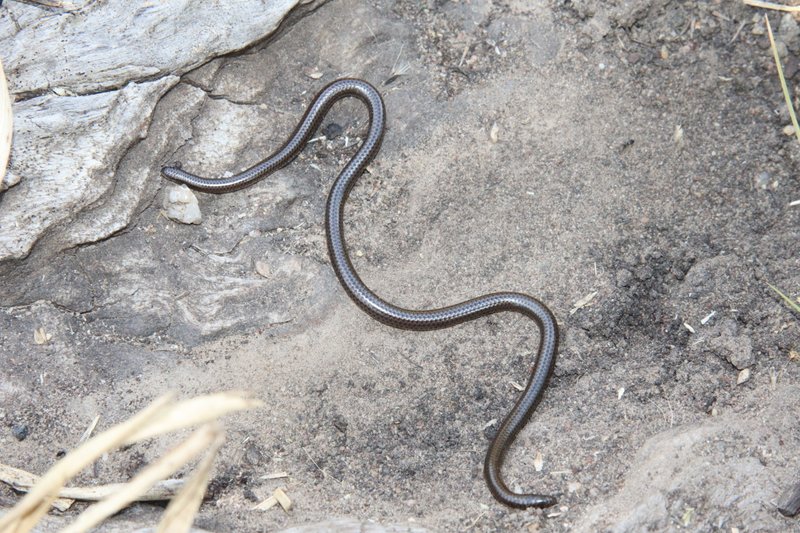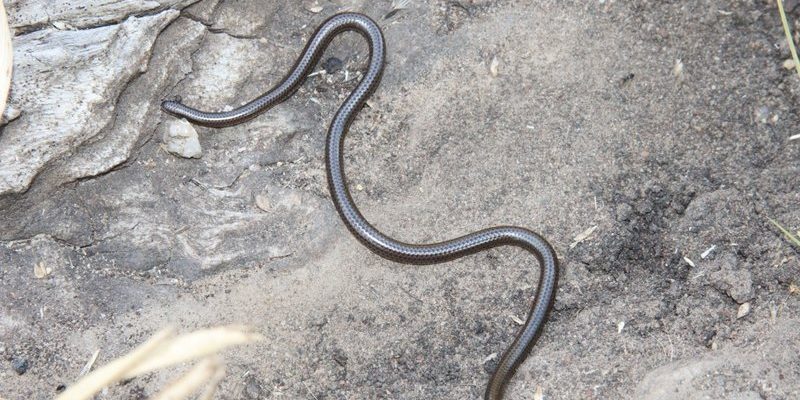
When you think of snakes, the image that probably pops into your mind is that of a sleek, slithery creature basking under the sun. But there’s a whole other world beneath the surface—quite literally! Meet Leptotyphlops, commonly known as slender worm snakes. These fascinating little creatures are so unique that they might just change the way you see snakes entirely. Imagine a creature that looks more like a worm than a conventional snake, and you’re on the right path.
Leptotyphlops is a genus of non-venomous snakes with an incredible ability to go unnoticed in their natural habitat. They’re small, often measuring just a few inches long, and have a distinct, cylindrical body that helps them burrow effortlessly in the soil. As you read on, you might find yourself intrigued—how can something so seemingly insignificant play a significant role in its ecosystem? Well, let’s dig deeper!
What Is Leptotyphlops?
Leptotyphlops refers to a genus in the family Typhlopidae, which comprises about 30 distinct species. These snakes are found primarily in Africa, the Middle East, and parts of the Americas, thriving in habitats ranging from dry grasslands to tropical forests. One of the most remarkable traits of Leptotyphlops is their reduced eyesight; they are burrowing specialists and rely more on touch and smell than on vision. Think of them as the ultimate underground dwellers, honing skills that suit their lifestyle.
These snakes have smooth scales that help them glide easily through the soil. Their streamlined bodies allow them to burrow rapidly, avoiding predators and searching for their favorite food—mainly ants and termites. If you’re picturing a creature that’s adapted perfectly to its environment, you’re spot on. Their life underground isn’t just about survival; it’s a specialized existence that speaks volumes about adaptability.
Physical Characteristics
Leptotyphlops snakes boast a number of intriguing physical features that make them stand out from more typical snakes. For starters, their bodies are slender and elongated, sometimes resembling a thick worm, which helps them escape the notice of both predators and prey. They can be anywhere from 10 to 30 inches long, but you would hardly call them bulky! Their colors vary, usually showcasing muted tones like browns, tans, or gray, which help them blend seamlessly into their subterranean surroundings.
Another interesting aspect of their anatomy is their head, which is often not much wider than their body. This design aids their impressive burrowing capability. If you’ve ever seen a snake struggle to navigate tight spaces, you’ll understand the advantage of a narrow head. Their eyes are so small that they can often go unnoticed; in fact, you might mistake them for a tiny scale if you’re not looking closely enough.
Moreover, the skin of Leptotyphlops is smooth and shiny, which not only offers camouflage but also aids in moisture retention, an essential trait for life in sometimes dry conditions. Their unique adaptations are a fantastic example of how nature fine-tunes creatures to thrive in their environments, ensuring their survival in versatile conditions.
Habitat and Distribution
Leptotyphlops snakes are primarily found in various regions throughout Africa, the Middle East, and parts of the Americas. They prefer habitats that offer soft, loose soil for burrowing, such as grasslands, savannas, and tropical forests. These areas not only provide them with ideal conditions for digging but also an abundance of their favorite food—ants and termites. If you imagine them as tiny gardeners of the soil, you’d be right! They play a role in aerating the ground as they tunnel, which can help plants flourish.
Interestingly, the specific species within Leptotyphlops can vary significantly in their habitat preferences. Some are well-adapted to arid environments, while others thrive in more humid, tropical climates. This adaptability is crucial for their survival, allowing them to find a niche wherever they land. So, if you’re ever wandering through the savanna or a lush forest and see a slight disturbance in the soil, it might just be a slender worm snake going about its business!
What’s more fascinating is that these snakes often remain hidden from the eye. In many cases, you might only become aware of their presence through their burrowing activities. This characteristic can render them elusive, adding an element of mystery and intrigue to their nature. Think of them as the secret agents of the animal kingdom, working silently behind the scenes!
Diet and Feeding Habits
When it comes to diet, Leptotyphlops has specific taste preferences that suit its unique lifestyle. These snakes primarily feast on ants and termites, which are abundant in their underground habitats. Just like a gourmet chef carefully selects ingredients, Leptotyphlops has evolved perfectly to find these tiny morsels hidden beneath the soil. They don’t just eat any insects; their long, slender bodies allow them to effectively access and consume these small prey with ease.
Feeding is a fascinating process for these snakes. They don’t hunt in the traditional sense; rather, they rely on their acute sense of smell and the vibrations in the soil to locate their food. When they detect an ant or termite colony, they use their elongated tongues to gather information about their environment—much like how we might use our fingers to navigate a complex shifting maze.
Once they locate their meal, they use their sharp, backward-facing teeth to grasp their prey, preventing it from escaping. This method is especially efficient when dealing with small, fast-moving insects. Imagine trying to catch a tiny, wriggling worm; it’s all about precision and technique! The proficiency of Leptotyphlops in its feeding habits is just another testament to its extraordinary adaptation in the wild.
Reproduction and Lifespan
Leptotyphlops exhibits fascinating reproductive behavior that adds another layer of intrigue to their already captivating life cycle. Like many snakes, these slender creatures are oviparous, meaning they lay eggs. The female typically lays between two to six eggs at a time, often buried beneath the soil in a safe, moist environment. This strategy protects the eggs from potential predators while providing ideal conditions for development, much like how we might tuck a child into a warm bed for a comfortable night’s sleep.
The incubation period lasts around eight to twelve weeks, depending on environmental factors such as temperature and humidity. Once hatched, baby Leptotyphlops emerge fully formed and ready to begin their independent lives right away. They waste no time acclimatizing to their surroundings, often seeking shelter in the very soil where they were born. Just imagine being sent off into the world with everything you need right beneath your feet!
As for lifespan, Leptotyphlops generally live around 5 to 10 years in the wild, although some species have been known to surpass this. In captivity, with proper care, they may live even longer. Their longevity reflects the resilience and adaptability of these remarkable snakes, as they continue to thrive in complex ecosystems despite their minimalistic lifestyle. It’s a testament to nature’s ability to find a way, no matter the environment.
Conservation Status
While the Leptotyphlops genus is not currently classified as endangered, various species within it face challenges due to habitat destruction and climate change. As with many creatures that dwell beneath the surface, their existence is often overlooked by conservation efforts. Deforestation, urbanization, and agricultural expansion disrupt not only their habitats but also their food sources, putting pressure on local populations.
In some areas, certain species of Leptotyphlops have seen declines due to these activities. Their specialized diets mean they rely heavily on specific environments, making them vulnerable to the loss of their natural habitats. Imagine being a tiny chef with a specific recipe, only to find your ingredients are disappearing. This reality paints a clear picture of the challenges faced by these beautiful snakes.
Conservation initiatives aimed at preserving local ecosystems can help safeguard the future of Leptotyphlops. Protecting their habitats ensures that they have the resources to thrive. You can play a part too—by advocating for sustainable practices and supporting local conservation efforts, you help create a brighter future for these underground wonders. Every little bit counts in the grand scheme of ecological balance.
Interesting Facts about Leptotyphlops
| Scientific Name: | Leptotyphlops |
| Size: | 10 to 30 inches |
| Habitat: | Diverse environments, including grasslands and tropical forests |
| Diet: | Primarily ants and termites |
| Reproduction: | Oviparous, laying 2 to 6 eggs |
| Lifespan: | 5 to 10 years in the wild |
FAQ
Where can I find Leptotyphlops snakes?
Leptotyphlops snakes are found primarily in Africa, the Middle East, and parts of the Americas. They thrive in habitats that provide soft, loose soil for burrowing, such as grasslands and tropical forests. If you’re exploring these areas, keep an eye out for subtle disturbances in the soil, which may indicate their presence.
Are Leptotyphlops snakes dangerous?
No, Leptotyphlops snakes are non-venomous and pose no threat to humans. They primarily feed on small insects like ants and termites. Their small size and burrowing nature make them unlikely to interact with people, which is a good thing for both parties!
How do Leptotyphlops find their food?
Leptotyphlops relies heavily on its sense of smell to locate food. These snakes can detect the vibrations in the soil caused by moving ants and termites, leading them to their meals. Their acute sense of smell allows them to navigate their environment efficiently, much like a skilled hunter tracking prey.
What do Leptotyphlops snakes eat?
The diet of Leptotyphlops primarily consists of ants and termites. These insects are abundant in their habitats, making them the perfect food source. The snakes have adapted their hunting techniques to efficiently catch these quick, underground dwellers.
How long do Leptotyphlops snakes live?
In the wild, Leptotyphlops generally live between 5 to 10 years. However, with the right care, individuals in captivity can live longer, sometimes exceeding 10 years. Their lifespan can be influenced by factors such as habitat quality and availability of food sources.
Do Leptotyphlops have any natural predators?
Yes, despite their adaptations for burrowing and evading detection, Leptotyphlops snakes can fall prey to a variety of predators in their ecosystem, including birds and larger reptiles. Their primary defense is to remain hidden underground, where they are less likely to be found.
What adaptations help Leptotyphlops survive underground?
Leptotyphlops snakes have developed several adaptations that allow them to thrive underground. Their elongated, slender bodies enable them to burrow easily, while their small eyes are less important since they rely more on their sense of smell and touch. Additionally, their smooth scales reduce friction as they move through the soil.
Can Leptotyphlops be kept as pets?
While keeping Leptotyphlops as pets is possible, they require specific care that many pet owners may not be equipped to provide. Their dietary needs and habitat conditions must be closely monitored to ensure their health and well-being. If you’re considering it, be sure to do extensive research to understand their requirements.
What threats do Leptotyphlops face in the wild?
Leptotyphlops snakes face various threats, including habitat destruction due to deforestation, urbanization, and agricultural expansion. Climate change can also negatively impact their food sources and habitats, making conservation efforts vital for their survival.
How can I help protect Leptotyphlops and their habitats?
You can help protect Leptotyphlops and their habitats by supporting conservation initiatives and advocating for sustainable practices. By raising awareness about the importance of preserving ecosystems, you contribute to the overall well-being of these amazing snakes and the biodiversity of their environments.

